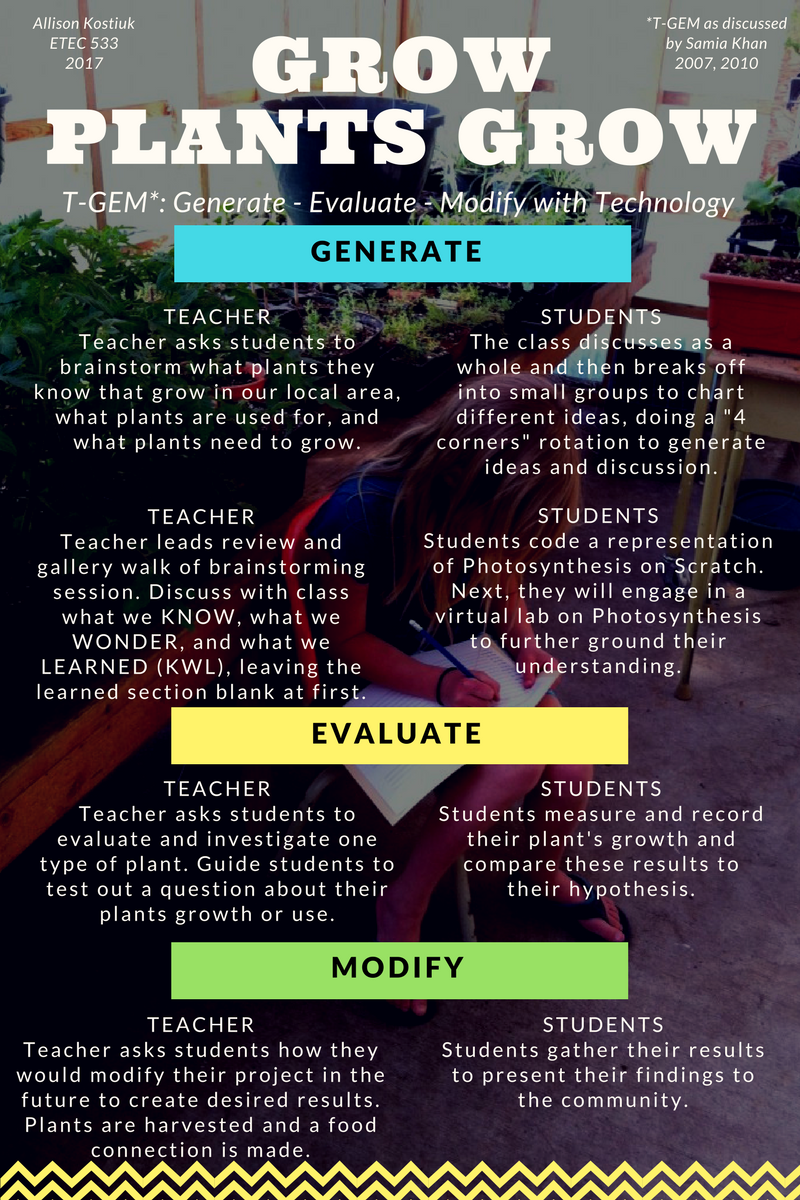For my TELE final project I chose to do an inquiry on plants with my grade 3’s integrating the T-GEM theory. I posted a link to my project in the Student Café and received some awesome feedback from some classmates (thank you!). If you would like to take a look at my project, here is the link: https://etec533.wixsite.com/growplantsgrow
I chose to create a graphic outlining my steps using the T-GEM learning theory.

The virtual lab I would integrate into the generate phase would be this virtual lab on Light and Plant Growth to encourage students to think about possible hypotheses and questions for their own projects.
My fifth and final step is to incorporate a sharing aspect to showcase student learning. With this project the sharing would be in the form of a science fair with information on the project, a display of the plant(s) used, and a food connection sample for visitors to try.
As another technology connection, as Catherine suggested to me, I may also incorporate the creation of a digital story for students to showcase their observations made throughout the project in a creative way. Technology integration is a great way to enhance learning and offers additional ways for students to share and document their learning.
Khan, S. (2007). Model-based inquiries in chemistry. Science Education, 91(6), 877-905.
Khan, S. (2010). New pedagogies for teaching with computer simulations. Journal of Science Education and Technology, 20(3), 215-232.
Allison, Your infographic captures the theme of this week on information visualization by highlighting the pedagogy and the active roles both the teacher and the students play. It also illuminates where the technology enters and how scientific processes and content are merged in this multi-layered TELE. Thank you also for providing the link to this interdisciplinary plan and to your peers for already providing feedback. The site is already developing with video, graphics, and images of students at work. The label of the pedagogic phases on the site were also tagged nicely with a representative symbol and aligned with the weeks of the plan–both were really helpful. A few thoughts on the grouping of activities and a question on each phase as this is a great opportunity to sponsor discussion on G-E-and M. Thank you!
The Generate phase has a nice connection to art for students. Here, students will be generating -generate ideas about what plants grow locally
It’s a higher order activity to have children then generate categories for their groups of plants. The categories activity should provide insights into their conceptual schemes on plants. It will be interesting to put these categories and the brainstorm on display.
I’m wondering how you see the segue from this activity to the how are plants used survey (eg. do you see this as one of the categories that they generated earlier that they then explore further). Technically, we might consider this an evaluation of their original list of ideas since they are “gathering new data”.
There is also a review component to the generation phase involving reviewing the parts of a plant (art activity), and photosynthesis (using Scratch). Finally, students are primed here to use the Psynth virtual lab with an exploration of the colours of the light spectrum which cause the most plant growth. (This too might be considered an evaluation of their understanding of photosynthesis, especially if it enriches or enhances what they were able to show initially in Scratch).
Evaluation of their knowledge of plants occurs here by the students undertaking the creation and design of their own tests. This is a wonderful way to spark student inquiry and provide scaffolding. I liked also the literary connection to the Curious Garden and the creation of an observation booklet, as well as the the reference back to the ideas generated on plants that growing their local area and their uses and the inclusion of sample testable questions that a student could pursue. Consider carrying on the use of scientific processes in the plan by asking students to make a prediction after developing their question. For the hypothesis piece in their worksheet, consider asking what they think will happen and adding “and why”.
Developing a good question often is one of the challenging parts for scientific inquiry (so iin your experience, are their good scaffolds or resources you have employed for this?). In terms of gathering data based on the question being asked, one might consider this part under evaluate rather than under the modify phase (depending on how it is viewed), as the children appear to be gathering new data to evaluate their understanding or original hypothesis. For the conclusion in the worksheet, if you wish, you may add “What new test would you like to try with this plant?”
Modify. The arrow going back nicely highlights that there is a cyclical nature to T-GEM. At this point, students will have concluded their evaluation of their original ideas (through the conclusion of their test) and aim to modify their original hypotheses/idea/ prior knowledge here.
For this to occur, it would be interesting to consider going back to their original brainstorm or their 4 corners chart (or another artefact they created. Students could be asked, for example “How would they modify their ideas about plants? What would they now add?” The collective will be interesting to view.
It would be wonderful to hear how this well thought out project goes this year!
Samia